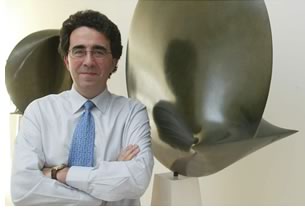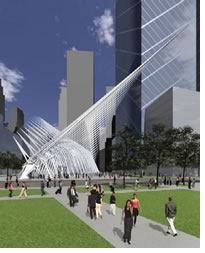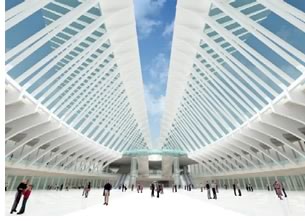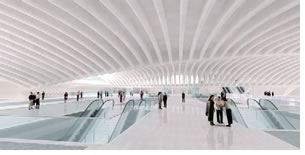

Calatrava Unveils Design for WTC Transit Hub
 Santiago Calatrava
unveiled his concept for the World Trade Center Transportation Hub January
22, revealing a design that he says honors those who perished in the September
2001 terrorist attacks, inspires survivors, and significantly improves
mass-transit connections across Lower Manhattan.
Santiago Calatrava
unveiled his concept for the World Trade Center Transportation Hub January
22, revealing a design that he says honors those who perished in the September
2001 terrorist attacks, inspires survivors, and significantly improves
mass-transit connections across Lower Manhattan.
Calatrava’s plans for the $2 billion project call for an open-air design to link the ferries, trains, commuter trains, and subway lines that converge at the World Trade Center site. A glass roof above the hub’s freestanding grand pavilion features ribbed arches that evoke a cathedral. The roof can be opened each year in remembrance of the September 11 attacks and can provide ventilation and natural air conditioning. The hub will pay tribute to the 84 Port Authority employees who died in the attacks.
 “This
is the Port Authority’s gift to New York City,” Calatrava
said. “It will be a lamp in the middle of Lower Manhattan, creating
an unbroken line of natural light from the platforms to the sky.”
“This
is the Port Authority’s gift to New York City,” Calatrava
said. “It will be a lamp in the middle of Lower Manhattan, creating
an unbroken line of natural light from the platforms to the sky.”
At the unveiling, New York Gov. George Pataki said, “The soaring design for the World Trade Center Transportation Hub completes the promise of Daniel Libeskind’s master plan for the site, skillfully complementing the designs for the 1,776-foot Freedom Tower and the Memorial. Santiago Calatrava’s masterpiece will one day take its rightful place among New York City’s most inspiring architectural icons. Millions of commuters and visitors will pass through this spectacular new transit hub when they come to Lower Manhattan.”
 For
inspiration, Calatrava turned to the New York City’s old Pennsylvania
Station and Grand Central Terminal. Natural light will stream onto the
transportation platforms 60 feet below ground. It will also have a large
open plaza, shops, restaurants, and mechanical walkways that connect passengers
to ferry service at the World Financial Center and other walkways that
link the terminal to 14 downtown subway lines.
For
inspiration, Calatrava turned to the New York City’s old Pennsylvania
Station and Grand Central Terminal. Natural light will stream onto the
transportation platforms 60 feet below ground. It will also have a large
open plaza, shops, restaurants, and mechanical walkways that connect passengers
to ferry service at the World Financial Center and other walkways that
link the terminal to 14 downtown subway lines.
Untangling a transit knot
Last summer, the Port Authority of New York and New Jersey selected the
Downtown Design Partnership, in association with Calatrava, to design
the transportation hub. The partnership is led by the joint venture of
DMJM+Harris and STV Group, Inc. According to Calatrava and the Port Authority,
the $2 billion project will include:
- A permanent Port Authority Trans-Hudson (PATH) terminal that eventually will serve more than 80,000 daily PATH riders, including tens of thousands of commuters and millions of annual visitors to the World Trade Center Memorial
- Pedestrian connections that will significantly improve access to PATH, ferries, and subway lines across Lower Manhattan; by 2020, these connections are expected to accommodate 250,000 daily commuters and visitors
- Greater open space in the Wedge of Light Plaza and additional access from two major streets
- State-of-art safety, security, and environmental enhancements.
 Port
Authority Executive Director Joseph J. Seymour explained that significance
of the transportation hub at the World Trade Center site is “nothing
short of historic. We will finally untangle Lower Manhattan’s knotted
network of confusing mass-transit connections, which have hindered this
part of the city for a century.” Officials expect the new terminal
to accelerate Lower Manhattan’s Economic recovery. The Permanent
PATH terminal is expected to begin serving passengers by the end of 2005.
All elements of the World Trade Center Transportation Hub are scheduled
for completion by 2009.
Port
Authority Executive Director Joseph J. Seymour explained that significance
of the transportation hub at the World Trade Center site is “nothing
short of historic. We will finally untangle Lower Manhattan’s knotted
network of confusing mass-transit connections, which have hindered this
part of the city for a century.” Officials expect the new terminal
to accelerate Lower Manhattan’s Economic recovery. The Permanent
PATH terminal is expected to begin serving passengers by the end of 2005.
All elements of the World Trade Center Transportation Hub are scheduled
for completion by 2009.
Copyright 2004 The American Institute of Architects.
All rights reserved. Home Page ![]()
![]()
 |
||
| View or
download (right-click) a PowerPoint presentation from the Port Authority’s
Web site.
|
||